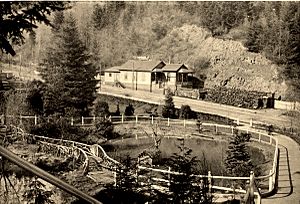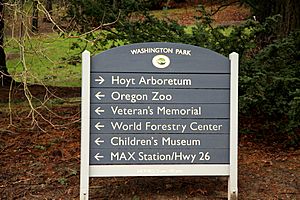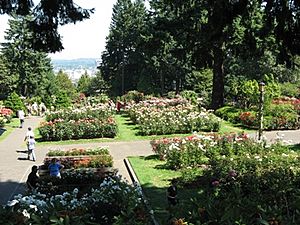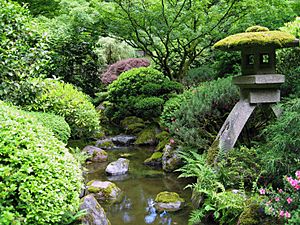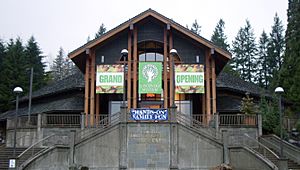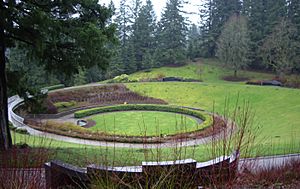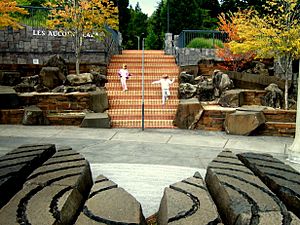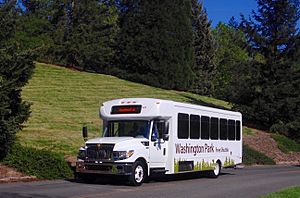Washington Park (Portland, Oregon) facts for kids
Quick facts for kids Washington Park |
|
|---|---|
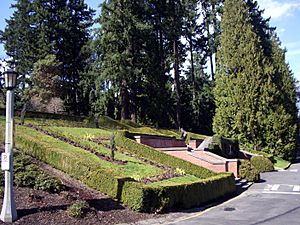
The park's main entrance, 2006
|
|
| Lua error in Module:Location_map at line 420: attempt to index field 'wikibase' (a nil value). | |
| Nearest city | Portland, Oregon, United States |
| Area | 458.45 acres (185.53 ha) |
| Created | 1909 |
| Operated by | Portland Parks & Recreation |
Washington Park is a huge public park in Portland, Oregon. It's a super fun place with lots to see and do! You can find the Oregon Zoo, a museum about trees, a beautiful tree garden, a children's museum, and amazing rose and Japanese gardens.
The park also has an amphitheatre for shows, special memorials, an archery range, tennis courts, a soccer field, and places for picnics and playgrounds. Plus, there are many acres of wild forest with miles of trails for exploring.
Washington Park covers more than 458 acres (185 hectares) of mostly steep, wooded hills. The land goes from about 200 feet (61 meters) high to 870 feet (265 meters) high! The park includes 241 acres (97.71 hectares) of city park land, plus the 64-acre (26-hectare) Oregon Zoo and the 153-acre (62-hectare) Hoyt Arboretum. All these areas together are known as Washington Park.
Contents
- History of Washington Park
- Fun Features of Washington Park
- International Rose Test Garden
- Washington Park Amphitheater
- Hoyt Arboretum
- Oregon Zoo
- Washington Park & Zoo Railway
- Portland Japanese Garden
- World Forestry Center Discovery Museum
- Oregon Vietnam Veterans Memorial
- Rose Garden Children's Park
- Washington Park MAX Station
- Portland Children's Museum
- Oregon Holocaust Memorial
- Himalayan Cloud Forest Garden
- Public Art and Fountains
- Getting to Washington Park
History of Washington Park
The City of Portland bought the first part of Washington Park in 1871. It was 40.78 acres (16.5 hectares) of wild land with few roads. It had thick bushes, trees, and even cougars!
In the mid-1880s, Charles M. Meyers became the park keeper. He used his memories of parks in his home country of Germany to transform the park. By 1900, the park had roads, trails, lawns, neat hedges, flower gardens, and a zoo. Cable cars were added in 1890 to help people get around. They ran until the 1930s.
In 1903, a famous landscape architect named John Charles Olmsted suggested some changes. He recommended the park's current name, a new entrance, separate paths for walking and driving, and using more native plants. The park was officially renamed Washington Park in 1909.
In 1922, the city bought more land, adding 160 acres (64.75 hectares) to the park. This led to the creation of the Hoyt Arboretum in 1930.
The Oregon Zoo's Journey
Portland's zoo started in Washington Park in 1888. It was near the north end of the park. The old bear house from this first zoo is now a park building.
The zoo moved in 1925 to where the Japanese Garden is now. The only building left from that second zoo is the elephant barn. It's now a picnic shelter, decorated with cool animal mosaics and a brick sculpture of an elephant. The zoo moved again in 1959 to its current spot at the south end of the park.
Museums and Learning Centers
In 1958, the Oregon Museum of Science and Industry (OMSI) opened a new building in the park. Next to it, the World Forestry Center opened its forestry museum in 1971. OMSI moved to a new location in 1992. In 2001, the Portland Children's Museum took over OMSI's old building.
In 2018, the Portland City Council made a plan for the park's future. This plan aims to improve transportation and access within the park over the next 20 years. It also includes updates for park features like the arboretum.
The city is also updating the park's old water reservoirs. They are replacing two outdoor reservoirs with new underground ones. These will be covered by reflecting pools. This project is expected to be finished by the end of 2023.
Fun Features of Washington Park
Washington Park has over 15 miles (24 km) of trails! Some of these trails connect Washington Park to other cool places like Pittock Mansion and Forest Park. The Wildwood Trail starts here. In 2019, the city built the Barbara Walker Crossing to help people safely cross a busy street on the Wildwood Trail.
International Rose Test Garden
The International Rose Test Garden is very special. It's the oldest public rose test garden in the United States that has been open continuously. It opened in 1924 and has more than 10,000 rose plants of over 650 different types! Inside, you'll also find a Shakespeare garden and a hidden "secret garden."
Washington Park Amphitheater
The Washington Park Amphitheater is right in the Rose Garden. Many public concerts happen here, including the Washington Park Summer Festival. This is a free concert series that usually takes place in August.
Hoyt Arboretum
The Hoyt Arboretum is like a giant outdoor museum of trees. It has almost 6,000 individual trees and shrubs from over 2,000 different kinds! It covers 153 acres (63.92 hectares) and was started in 1928. Twelve miles (19 km) of the park's trails are located in the arboretum.
Oregon Zoo
The Oregon Zoo opened at its current spot in 1959. It's home to more than 2,500 animals from over 200 different species. This includes 15 endangered and 7 threatened species! The zoo is famous for its Asian elephant breeding program. A baby elephant named Packy was born here in 1962. When he grew up, he was the biggest elephant of his kind in North America!
Washington Park & Zoo Railway
The Washington Park & Zoo Railway is a fun train ride! It's a narrow-gauge railroad from the 1950s. It was designed to take passengers on a 2-mile (3.2 km) trip between the Rose Garden and the zoo. It opened in stages from 1958 to 1960. Right now, part of the track is closed for repairs, so the train only runs within the zoo.
Portland Japanese Garden
The Portland Japanese Garden is a beautiful 9.1-acre (3.7-hectare) traditional Japanese garden. It opened in 1967. Experts have called it the best Japanese garden in North America among over 300 others!
World Forestry Center Discovery Museum
The World Forestry Center Discovery Museum teaches you all about forests. It has exhibits on forests from around the world. It was first started in 1906 and moved to Washington Park in 1971. You can learn about different types of trees, animals, and how we use wood.
Oregon Vietnam Veterans Memorial
The Oregon Vietnam Veterans Memorial was built in 1987. It honors people from Oregon who were killed or went missing during the Vietnam War.
Rose Garden Children's Park
The Rose Garden Children's Park is a playground that opened in 1995. It has a big, colorful play structure designed for all children, including those with disabilities. Next to it is the Elephant House picnic shelter, which used to be the old zoo's elephant barn!
Washington Park MAX Station
The Washington Park station is a train stop located deep underground. It's beneath Les AuCoin Plaza, a pretty brick and stone area between the zoo and the World Forestry Center. At 260 feet (79 meters) below ground, it's the deepest transit station in North America! You get to it by four super-fast elevators. It opened in 1998.
Portland Children's Museum
The Portland Children's Museum started in 1946. It moved into the old OMSI building in 2001. The Children's Museum has a large 1.3-acre (0.53-hectare) outdoor play area. They also run a special school.
Oregon Holocaust Memorial
The Oregon Holocaust Memorial was built on August 29, 2004. It honors the victims of the Holocaust.
Himalayan Cloud Forest Garden
This garden was created around 2010. It's a 3-acre (1.2-hectare) area at the north end of the park. It has over 200 types of rhododendrons and many other plants, mostly from the Sino-Himalayan region.
The veterans memorial, zoo, children's museum, forestry center, and the MAX station are all around a big parking lot in the southwest part of the park. The arboretum is just north of these. The gardens, amphitheater, playgrounds, and the Holocaust Memorial are in the northeast section of the park.
Public Art and Fountains
Washington Park has many interesting sculptures and fountains.
- Chiming Fountain is a beautiful fountain from 1891. It's called "Chiming Fountain" because of the sound the water makes as it falls. It has cool gargoyles!
- The Lewis and Clark Memorial Column is a granite monument from 1903. It honors the famous Lewis and Clark Expedition that explored the northwest.
- Coming of the White Man is a bronze statue from 1904. It shows two Native Americans, including Chief Multnomah. It faces east, looking along the Oregon Trail.
- Sacajawea and Jean-Baptiste is a large bronze statue from 1905. It shows Sacajawea, the brave Shoshone woman who helped guide the Lewis and Clark Expedition through the mountains.
- The Loyal B. Stearns Memorial Fountain was built in 1941 to honor a former Oregon judge.
- The Continuity of Life Forms is a mosaic by Willard Martin. It was first put up at the Oregon Zoo's old entrance in 1959. It was moved to the zoo's new education center in 2016.
- Frank E. Beach Memorial Fountain (also called Water Sculpture) is a cool stainless steel fountain in the Rose Garden. It was designed by Oregon artist Lee Kelly and dedicated in 1975.
- House for Summer is a living sculpture of Himalayan birch trees. Artist Helen Lessick planted it in the Hoyt Arboretum in 1987. It changes with the seasons!
- Royal Rosarian is a bronze statue in the Rose Garden from 2011. It shows a Royal Rosarian tipping his hat.
- Basket of Air is a metal sculpture by Ivan McLean. It looks like a basket and hangs over a pond in the Hoyt Arboretum's Bamboo Forest. It was installed in 2016.
In 2001, a special bench and plaque were placed near the Lewis and Clark Memorial. They honor John Reed, a journalist born in Portland. The plaque has a quote from him about how beautiful Portland is.
Getting to Washington Park
Parking in Washington Park costs money, usually $2 per hour, up to $8 for a whole day.
You can easily get to the park using public transportation! The Washington Park light rail station is an underground stop on the MAX Light Rail system.
Once you're in the park, you can use the Washington Park Shuttle. This shuttle is free and connects to the MAX light rail station. It runs every day from April to October, and on weekends from November to March.
There are also TriMet bus routes that serve the park. Bus route 63-Washington Park/Arlington Heights stops at the west and east ends of the park, including the Rose Garden and Japanese Garden. Bus route 20-Burnside/Stark serves the northeastern corner of the park.


